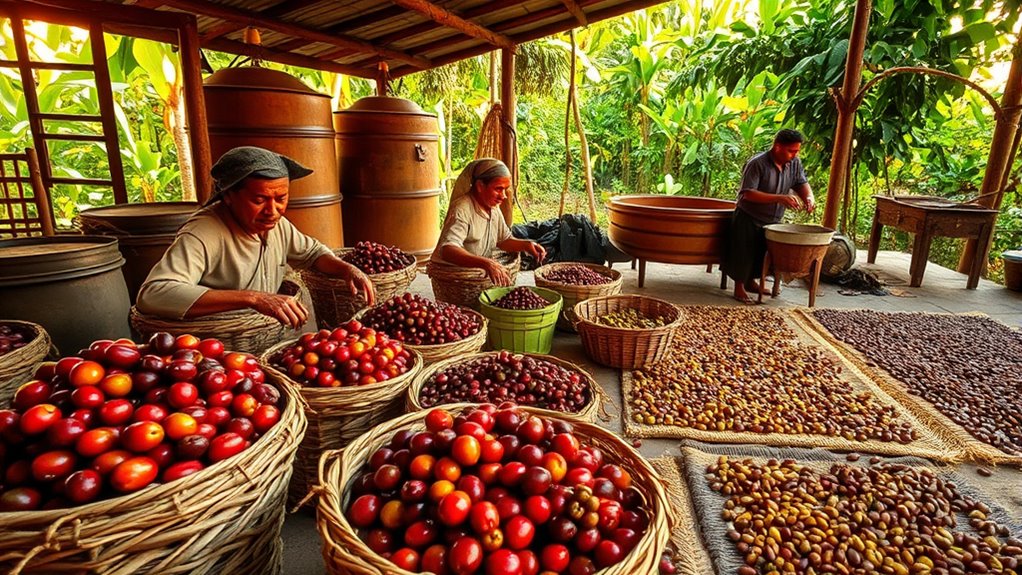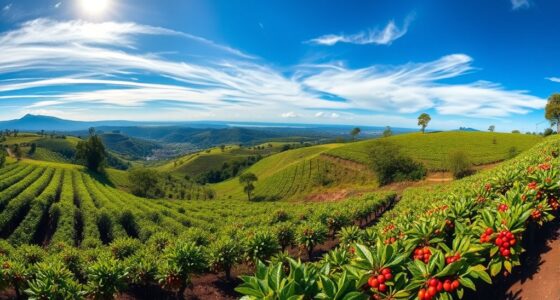Regional traditions greatly influence coffee processing methods, shaping unique fermentation and drying techniques that impact flavor. For example, Central America often uses washed processing for bright, crisp notes, while Africa favors natural fermentation that highlights fruity, berry flavors. Environmental factors and cultural customs guide these methods, creating regional character in each cup. Understanding these differences helps you appreciate how tradition influences taste; exploring further reveals even more about these fascinating regional differences.
Key Takeaways
- Regional fermentation techniques, such as washed or natural processes, directly influence the coffee’s acidity, fruitiness, and overall flavor profile.
- Traditional drying methods, like sun-drying or mechanical drying, impart regional characteristics like brightness or richness to the final coffee.
- Cultural practices and environmental conditions shape processing methods, creating distinctive flavor signatures unique to each region.
- Fermentation duration and methods reflect local heritage, affecting sweetness, complexity, and cup clarity.
- Processing techniques serve as cultural markers, contributing to the regional identity and sensory profile of regional coffees.

Coffee processing methods determine the flavor and quality of your final brew. When you start with freshly harvested coffee cherries, the choices you make in fermentation techniques and drying methods have a direct impact on the taste profile you experience in your cup. Fermentation is a critical step where natural or controlled microbial activity breaks down sugars and pulp, influencing acidity, sweetness, and overall balance. Some regions favor washed processing, where cherries undergo fermentation in water to remove mucilage thoroughly, resulting in cleaner, brighter flavors. Others use natural or dry fermentation, where cherries are left to ferment with their pulp intact, often producing fruitier, more complex notes. These fermentation techniques can vary based on local traditions and environmental conditions, giving each region its distinctive character. fermentation techniques play a vital role in defining regional flavor profiles and reflect cultural practices.
Coffee processing shapes flavor, with fermentation and drying techniques reflecting regional traditions and environmental influences.
Drying methods, too, play a essential role in shaping your coffee’s flavor. After fermentation, the beans must be dried to reduce moisture content and prevent spoilage. In some regions, coffee is sun-dried on large patios or raised beds, exposing the beans to direct sunlight and allowing natural airflow. This slow drying process can imbue the beans with unique regional flavors, often enhancing fruitiness and body. Conversely, mechanically dried beans are dried in controlled environments, which help maintain consistency and reduce the risk of over-drying or mold. The choice of drying method can influence the final aroma and taste, with sun-dried coffees often exhibiting a richer, more vibrant profile and mechanically dried beans tending to be cleaner and more uniform.
Your region’s climate, altitude, and processing traditions shape these techniques, making each coffee unique. For example, Central American coffees often undergo washed processing with meticulous fermentation and sun-drying, resulting in bright, crisp cups. In contrast, many African coffees utilize natural fermentation and sun-drying on raised beds, imparting intense fruit and berry notes. South American processing might blend different fermentation techniques and drying methods to achieve a balanced, nuanced flavor.
Understanding how fermentation techniques and drying methods influence flavor can deepen your appreciation for regional differences in coffee. These steps are not just technical procedures but part of a cultural heritage that shapes the very essence of your brew. When you pick up a bag of coffee, you’re tasting the story of its processing, rooted in local traditions and environmental conditions. Every sip becomes a reflection of the region’s unique approach to fermentation and drying, making each cup a distinctive experience.
Frequently Asked Questions
How Do Local Climate Conditions Influence Coffee Flavor Profiles?
You might notice that local climate conditions greatly influence coffee flavor profiles. Microclimate effects, like temperature and humidity, shape how beans develop, while soil influence adds unique mineral notes. For example, cooler microclimates can produce brighter, more acidic coffees, whereas warmer areas yield bolder flavors. By understanding these factors, you can appreciate how each region’s climate and soil contribute to the distinctive taste you experience in every cup.
What Traditional Processing Methods Are Unique to Specific Coffee-Growing Regions?
You might find that processing rituals shape a coffee’s soul, with each region’s traditional methods offering subtle nuances. For example, Ethiopian naturals embrace sun-drying, enhancing fruity notes, while Costa Rican washed processes highlight brightness. Regional fermentation techniques, like the anaerobic methods in Guatemala, develop unique flavor complexities. These practices reflect local culture and history, making each coffee story richer and more meaningful, inviting you to savor its distinct character.
How Does Altitude Impact the Processing Techniques Used by Farmers?
Altitude effects markedly influence farming practices, which in turn affect processing techniques. Higher elevations often require farmers to adapt their methods due to cooler temperatures and slower bean maturation. You might notice that farmers at high altitudes focus on delicate harvesting and precise fermentation to preserve unique flavors. These altitude-driven adjustments guarantee the beans develop ideal qualities, ultimately shaping the coffee’s profile and highlighting the region’s distinct characteristics.
Are There Regional Variations in Fermentation Practices Affecting Taste?
You’ll notice regional variations in fermentation techniques, which substantially influence flavor. Different areas use distinct fermentation times, temperatures, and methods, shaping the coffee’s taste profile. These regional practices impact acidity, sweetness, and complexity, making each region’s coffee unique. By understanding how fermentation techniques vary regionally, you can better appreciate how these practices influence flavor and contribute to the diverse world of coffee, enhancing your tasting experience.
How Do Cultural Preferences Shape Processing and Flavor Development?
You see, cultural influence plays a key role in shaping processing diversity and, consequently, flavor development. When you embrace local traditions, you influence how coffee is processed, from fermentation to drying, which creates unique flavor profiles. Your preferences guide methods that reflect regional tastes, resulting in distinct coffees. This cultural approach guarantees each region’s coffee retains its identity, making the flavor experience rich and diverse for you to enjoy.
Conclusion
You might think processing methods don’t make much difference, but they truly shape each cup’s unique flavor. Regions’ traditions influence techniques that bring out specific notes and qualities, making every coffee experience special. Don’t overlook these differences—embracing them lets you appreciate the rich diversity in your brew. So next time, pay attention to how your coffee’s processed. It’s a simple way to deepen your enjoyment and truly savor the distinct character of each region’s beans.









